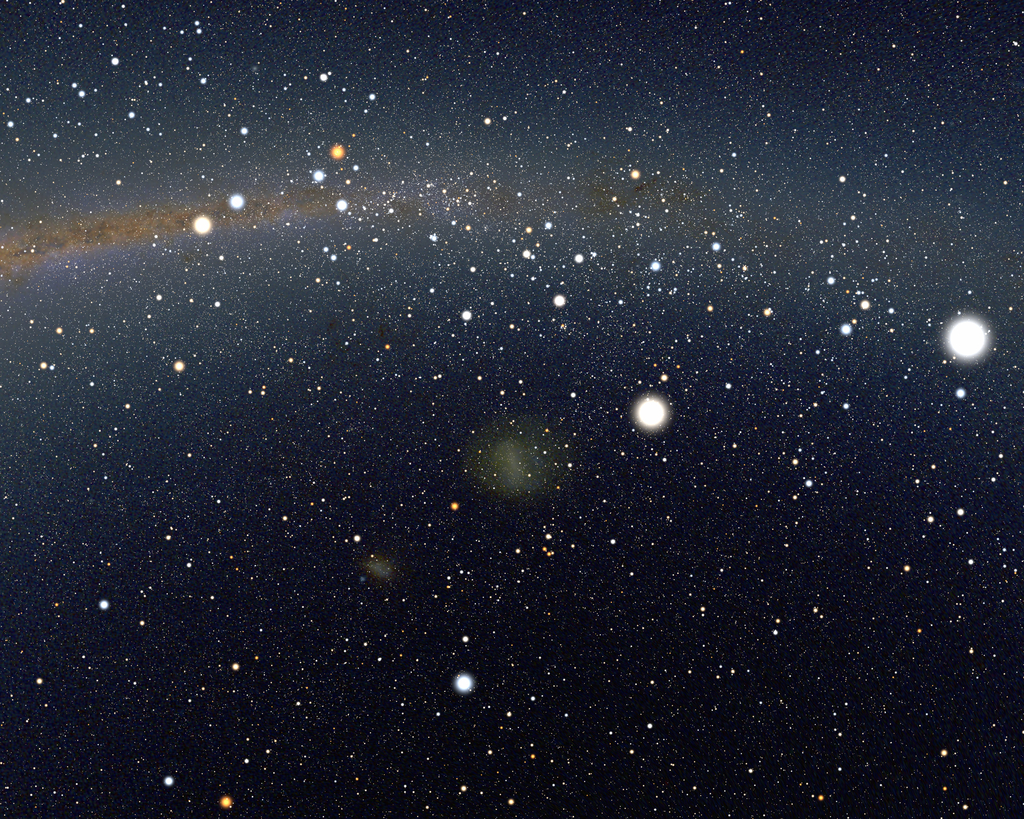Some details about the APOD of 2010 December 7
This picture is a computer generated image of the distortions caused by a spherically symmetric, uncharged (Schwarzschild) black hole. (Note: all the images of this page are under CC-BY-SA 3.0 licence. In case you intend yo reuse them, please credit my name and institution, i.e., Alain Riazuelo, IAP/UPMC/CNRS.)
This is to be compared with the picture without black hole:
This picture is familiar to many
amateur or professional astronomers. It is almost centered of the Large
Magellanic Cloud. Above it one easily notices the southernmost part of
the Milky Way with, from left to right, Alpha and Beta Centauri, the
Southern Cross, and then the huge Argo Navis, now splitted into three
constellations (from left to right, Carina, Vela and Puppis). At the
right of the picture, the brightest spot is Sirius, from Canis Major.
The second brightest star, close to the LMC is Canopus. The brightest
star of the lower part of the picture is Achernar, at the edge of
Eridanus.
If one zooms at the exact center of this picture, one sees an anonymous, undocumented 7.5 magnitude star, which happens to be HD 49359 (or HIP 32073, or SAO 249630):
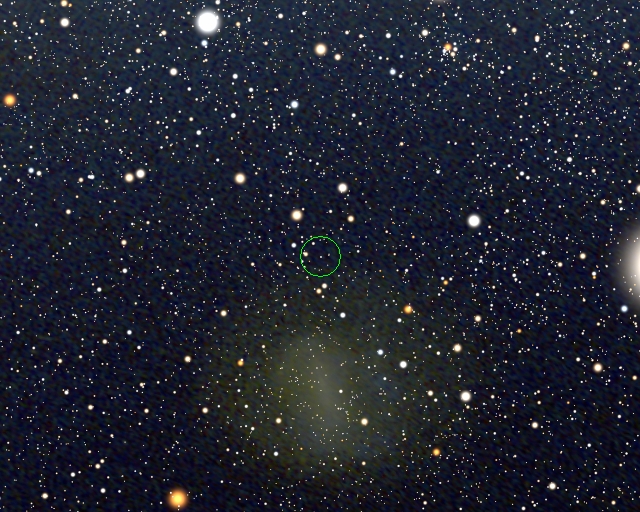
In fact, the celestial sphere we saw in the absence of the black hole is pushed away the Einstein ring. Between the Einstein ring and the edge of the black hole shadow, one has a copy of the whole celestial sphere. It is actually possible to connect any star seen within the Einstein ring to its primary image outside the ring. The segment that joins these two images always intersect the geometrical center of the black hole, and the closer is the primary image to the Einstein ring, the closer is its secondary image. The picture below shows some associations of two star images:
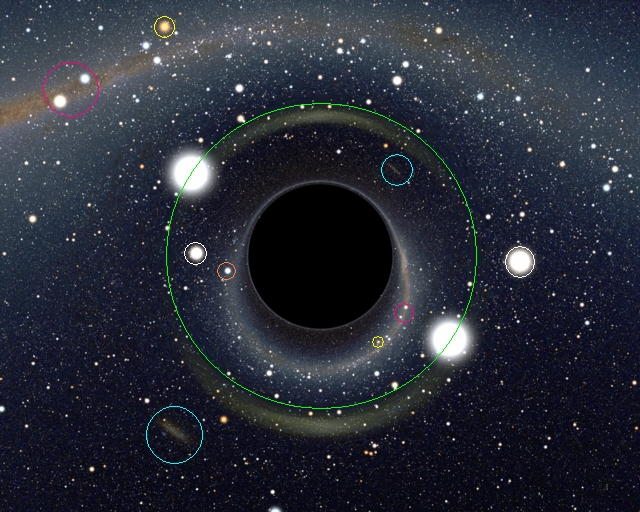
Some primary/secondary image association of bright astronomical objects. Cyan rings show the two images of the Small Magellanic Cloud. Magenta rings shows the two images of Alpha and Beta Centauri. The yellow rings show the two images of Gamma Crucis (the redder, uppermost star of the Southern Cross). The two images of Canopus are shown within the white rings. Primary image of Sirius is nolonger visible as it is now pushed beyond the right edge of the picture, but Sirius secondary image is visible at the left of the black hole.
If one zooms at the exact center of this picture, one sees an anonymous, undocumented 7.5 magnitude star, which happens to be HD 49359 (or HIP 32073, or SAO 249630):

When one puts a black hole (almost)
exactly between a star and the observer, then the star apparent
luminosity enormously increases and the star itself seems to split into
two separate images which are found at two opposite points of a circle
surrounding the balck hole shadow. This circle shows fewer but brighter
stars than the rest of the image is called the Einstein ring. This ring
shows a highly distorted and magnified view of what is exactly behind
the black hole:
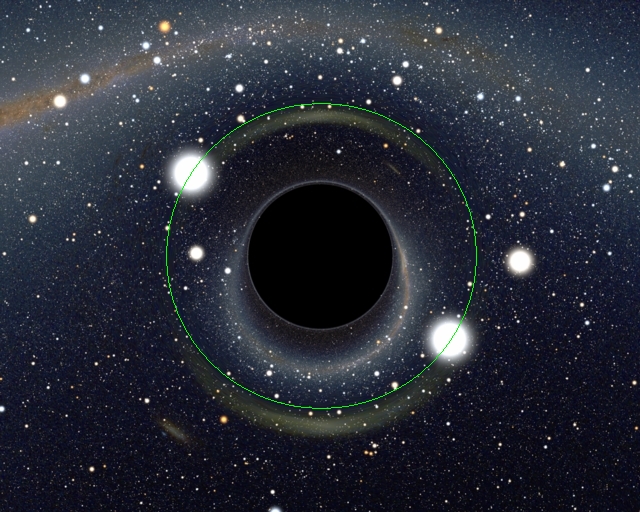
Approximate position of the
Einstein ring. The faint star HD 49359 appears as a set of two very
bright stars on two opposite points of the ring.
In fact, the celestial sphere we saw in the absence of the black hole is pushed away the Einstein ring. Between the Einstein ring and the edge of the black hole shadow, one has a copy of the whole celestial sphere. It is actually possible to connect any star seen within the Einstein ring to its primary image outside the ring. The segment that joins these two images always intersect the geometrical center of the black hole, and the closer is the primary image to the Einstein ring, the closer is its secondary image. The picture below shows some associations of two star images:

Some primary/secondary image association of bright astronomical objects. Cyan rings show the two images of the Small Magellanic Cloud. Magenta rings shows the two images of Alpha and Beta Centauri. The yellow rings show the two images of Gamma Crucis (the redder, uppermost star of the Southern Cross). The two images of Canopus are shown within the white rings. Primary image of Sirius is nolonger visible as it is now pushed beyond the right edge of the picture, but Sirius secondary image is visible at the left of the black hole.
Actually,
the
region
within the Einstein ring does not show a single copy of the
celestial sphere, but an infinity of such copies. However, all of these
except the first one are shrunk to a very thin line very close to
the edge of the black hole shadow. When looking carefully, it is
possibly to have a hint of their existence. In this picture, it becomes
obvious from the fact that one sees two faint spots which are perfectly
aligned with the two very bright images of HD 49359. They are
indeed
the second and third ghost image of this star:
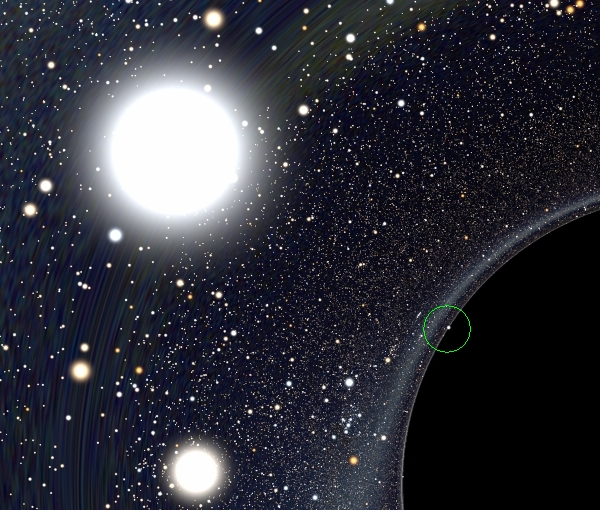
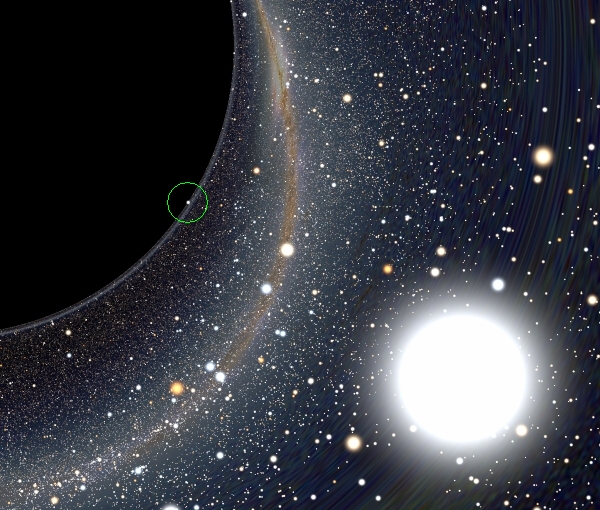


In the last images, we also see the
first ghost image of the Milky Way, together with the Southern Cross
ghost image. The faint glow that is a few pixels away the ghost image
of HD 49359 is in fact the second ghost image of the Milky Way. Also,
the even more faint glow that seems to touch the black hole shadow is a
third, now completely unrecognizable, ghost image of the Milky Way.
Should one zoom this image by a tremendous factor, we would see other
ghost images of the Milky Way.
For those who might be interested in technical details:
A few technicalities
For those who might be interested in technical details:
- The image was done using a starless background image, coming from the 2MASS survey.
- A realistic star catalogue (the Henry
Draper Catalogue) was added once the distortion of the image
was computed.
- This means that we have implicitely replaced our Sun by a black
hole, even though it is somehow astrophysically inconsistent.
- The black hole size or mass does not matter here. What matter is the ratio between the observer distance of the black hole and the black hole radius. Using the incorrect but common claim that distance are accurately expressed in term of the usual Schwarzschild coordinate, this ratio is here equal to 9, i.e., we are at R = 20 M in the usual Schwarschild coordinate system.
- Image opening angle is fairly large: 116 degrees. It was produced
on a flat screen using stereographic projection.
- Because of tidal effects, physiological constraints impose that
the black hole must be fairly massive in order an observer so close to
a black hole does not quickly become ripped apart by the black hole enormous
gravitational field. Putting such a massive black hole in the visinity
of our Solar System is, again, not 100% realistic.
- The 2560×2048 image was initially computed at a twice larger resolution (5k×4k) and then shrunk to its current size so a to allow smoother details.

